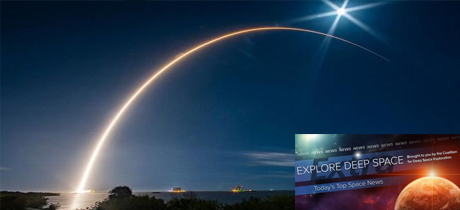In Today’s Deep Space Extra… The White House delivers its proposed 2021 budget to Congress today, with some reports that NASA could see a significant increase. The joint NASA/ European Space Agency (ESA) Solar Orbiter mission lifted off successfully late Sunday, following the last minute launch scrub of the latest resupply mission to the International Space Station (ISS).
Human Space Exploration
Trump’s budget proposal would give NASA one of the largest increases in years
Washington Post (2/7): President Trump delivers the administration’s 2021 budget proposal to Congress today. Some reports point to a request of more than $25 billion for NASA, with almost $3 billion devoted to the development of landers that can accelerate a human return to the surface of the Moon in 2024. The 2020 NASA appropriation stands at just over $22 billion this year.
Antares launch scrubbed due to faulty ground support equipment
Coalition Member in the News – Northrop Grumman
Spaceflightnow.com (2/9): An issue with ground support equipment at NASA’s Wallops Island Flight Facility launch pad for the Northrop Grumman Antares rocket prompted a scrub Sunday evening with less than three minutes left in the countdown. Antares will lift the Cygnus vehicle “S.S. Robert H. Lawrence” stocked with supplies and science to the International Space Station for the company’s 13th commercial cargo mission. The next launch attempt could come Thursday after troubleshooting.
Boeing software errors could have doomed Starliner’s uncrewed test flight
Coalition Member in the News – Boeing
Spacepolicyonline.com (2/7): A meeting of NASA’s independent Aerospace Safety Advisory Panel last Thursday revealed a second flight software issue that arose as Boeing’s uncrewed December CST-100 Starliner test flight was preparing to deorbit on December 22, one that could have caused a collision between the crew capsule and service module as they separated. The first issue arose late in the launch phase on December 20 when mistimed thruster firings prevented the spacecraft from raising its orbit to dock with the International Space Station (ISS). The two issues hint at perhaps many more issues that escaped notice by Boeing and NASA, a prospect that has prompted a deeper review of the Starliner’s development and NASA’s oversight.
Space Science
ESA’s Solar Orbiter will be the first spacecraft to study the sun’s polar zones
Coalition Member in the News – United Launch Alliance
Science News (2/9): The European Space Agency (ESA)/NASA Solar Orbiter mission launched Sunday at 11:03 p.m., EST, atop a United Launch Alliance (ULA) Atlas 5 rocket. The $1.5 billion mission is to include the closest observations yet of the Suns poles and the activities that drive a powerful solar wind and magnetic field whose influences stretch across the solar system and include the Earth’s environment. The mission will combine efforts with those of NASA’s Parker Solar Probe mission and the soon to debut Daniel K. Inouye Solar Telescope in Hawaii.
A new spacecraft is journeying to the Sun to get a never-before-seen look at the star’s poles
The Verge (2/8): The Solar Orbiter is a joint European Space Agency (ESA)/NASA mission to learn more about how the Sun works to create a powerful solar wind and magnetic field and their influences on the Earth and deeper into the solar system.
Voyager 2 bounces back from glitch in interstellar space
Space.com (2/7): NASA’s Voyager 2 spacecraft was launched to the outer planets in 1977 and has been breaking new ground since it entered interstellar space in November 2018. The transition prompted a halt on science operations. Last Thursday, NASA announced that it has been able to work with the spacecraft to restore observations.
Other News
Will Space Force oversight constrain SDA? Current and former bosses offer contrasting views
SpaceNews.com (2/7): The Pentagon’s Space Development Agency has an important role in its association with the new U.S. Space Force. However, experts disagree on how much independence should be preserved. Congress has called for the development agency to become part of the Space Force no later than 2022.
Space Coast Air Force bases will soon undergo Space Force name changes
WESH 2-TV of Florida (2/7): As part of the new U.S. Space Force, two Florida Space Coast U.S. Air Force installations will undergo future name changes. Patrick Air Force Base will become Patrick Space Force Base and Cape Canaveral Air Force Station will become Cape Canaveral Space Force Station.
Japan launches optical spy satellite to keep eye on North Korea
Japan Times (2/9): The Japanese reconnaissance satellite launched Sunday is believed to be a replacement for one of seven optical and radar surveillance satellites for reconnaissance in the region.
Iran again fails to put satellite into orbit amid U.S. worries
Associated Press (2/9): Iran failed in an attempt Sunday to launch the Zafar 1 communications satellite into orbit from a launch site southeast from Tehran. The U.S. has cautioned that Iran’s efforts are intended to develop a ballistic missile capability.
Major Space Related Activities for the Week
Major space related activities for the week of February 9-15, 2020
Spacepolicyonline.com (2/9): The Trump Administration on Monday presents its 2021 budget proposal to Congress. The spending plan includes NASA, which was funded at $22.6 billion for 2020. The 2021 request will seek a 12 percent increase, according to a Wall Street Journal report. A major funding topic will be the Human Landing System, commercially developed landers to shuttle future astronauts to the lunar surface from a lunar orbiting, human tended Gateway. NASA was directed by the White House last March to return to the Moon with human explorers in 2024, a four year advance. House and Senate authorization panels plan hearings Tuesday and Wednesday, with the House topic space situational awareness and planetary defense and the Senate topic space weather and space situational awareness.

